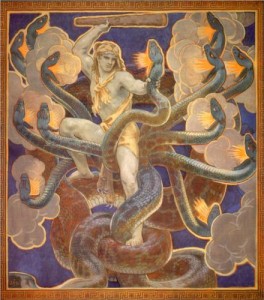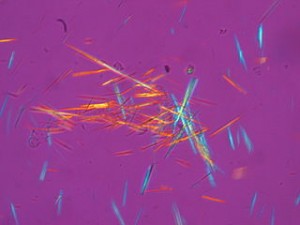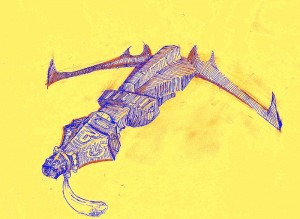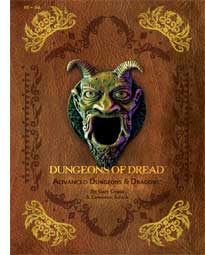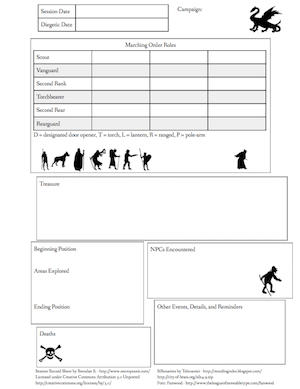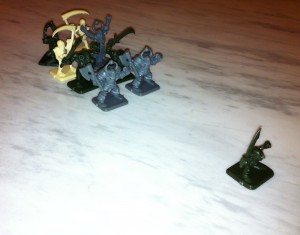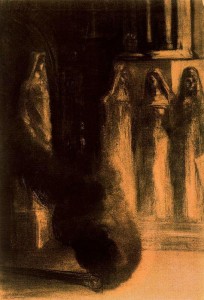
Odilon Redon, The Black Torches
Assume for a moment that you have a game artifact. This is a thing, to be “used” with your games in some way. Maybe it’s a setting write-up, or a module, or a bestiary. Maybe you wrote it, maybe someone else wrote it. First: it’s important to note that these things are all the same sort of thing at some level, and thus this is not just a discussion about modules, but of any product useful for gaming. But what does “use” actually mean? Consider the idea of affordances from ecology.
The affordances of the environment are what it offers the animal, what it provides or furnishes, either for good or ill. The verb to afford is found in the dictionary, but the noun affordance is not. I have made it up. I mean by it something that refers to both the environment and the animal in a way that no existing term does. It implies the complementarity of the animal and the environment.
That’s by Gibson, The Ecological Approach to Visual Perception, chapter eight: The Theory of Affordances (bold items were italicized in the original, but my theme blockquote style loses that).
Okay, that’s a lot of words; how about an example? From the same chapter:
The human species in some cultures has the habit of sitting as distinguished from kneeling or squatting. If a suface of support with the four properties is also knee-high above the ground, it affords sitting on. We call it a seat in general, or a stool, bench, chair, and so on, in particular. It may be natural like a ledge or artificial like a couch. It may have various shapes, as long as its functional layout is that of a seat. The color and texture of the surface are irrelevant. Knee-high for a child is not the same as knee-high for an adult, so the affordance is relative to the size of the individual. But if a suface is horizontal, flat, extended, rigid, and knee-high relative to the perceiver, it can in fact be sat upon. If it can be discriminated as having just these properties, it should look sit-on-able. If it does, the affordance is perceived visually. If the surface properties are seen relative to the body surfaces, the self, they constitute a seat and have meaning.
What are the affordances of a game-thing? I’m not talking about the physical object, but rather the affordances of the virtual objects that arise in the shared game space that players conjure together that derive directly from the game-thing. This is the use of the game-thing. Examples. A stat block (or perhaps HD + AC) affords fighting. If a thing has hit dice, it is fightable and killable. An exact site map affords constrained exploration and movement. A more abstract map (graph-style, perhaps) affords a different kind of movement and interaction (where relationships are more important than distances; see page 5 of this, by Patrick of False Machine). A treasure (in GP = XP games), or more generally a rewarded goal, affords character advancement.
Numbers and game mechanics are not the only (or even most important) affordances, however. Because as Roger put it, fluff is crunch. Thus, the adjective “covetous” attached to an NPC may afford more game utility than 100 stat blocks. If that is true though, what isn’t an affordance? Why are so many game-things so hard to use, so badly designed, and so padded with useless information? Some of it is just redundancy (text spent explaining that there are trees in the forest, or fish in the fish market, to borrow an anti-example from Vornheim). Some of it is prolixity (writing in full sentences what might better be apprehended as a list of keywords; there is a reason why referee notes are so often in this form, and it’s not because they are “unpolished”). And some of it is just bad organization (putting things that are likely to be needed together in separate places, thus requiring page flipping or even context switching between different books). That is, there are good forms of redundancy too. So, all those things are non-affordances that take up space in modules, and are all pretty much unarguably bad design.
Even factoring out those mistakes though, game-things are more than just affordances. That paragraph of imaginary history, or an evocative description which you won’t have time to read during a session but which might help communicate a mood. Like psychological priming, and memories, game-things have a lingering (and useful) influence on the consciousness of the referee. On that subject, a while ago on G+, I wrote (in retrospect, incorrectly):
In an adventure all of that backstory is useless unless it impacts the character’s adventures.
And James Raggi responded:
It colors the Ref’s attitude towards the material which should directly impact the way the adventure is run.
He’s right, and such details are often valuable, and can even be independently works of art in their own right, but such details do not afford game play. Further, unless such exposition is organized exceptionally well, this mood-filler detracts from the other useful ideas contained within the product, and may even render them inoperable. Then you get the dreaded wall of text experience where you can’t find the relevant details when you need them in play (and this can be critical to the functioning of the game-thing, such as clues for an upcoming trap, rumors about a nearby area, prophesies of a future doom, or weaknesses of a specific enemy).
The degree to which a game-thing, as game-thing, is game-functional is the number of affordances from the game-thing that are enabled to arise in actual play, and the degree to which the non-affordance aspects of the game-thing get out of the way. This is, I suspect, why so many game products work so poorly at the game table, despite being creative and enjoyable to read.

